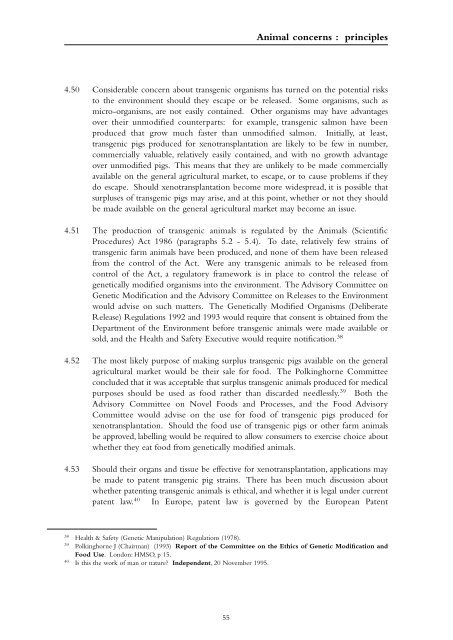Xenotransplantation - Nuffield Council on Bioethics
Xenotransplantation - Nuffield Council on Bioethics
Xenotransplantation - Nuffield Council on Bioethics
You also want an ePaper? Increase the reach of your titles
YUMPU automatically turns print PDFs into web optimized ePapers that Google loves.
Animal c<strong>on</strong>cerns : principles<br />
4.50 C<strong>on</strong>siderable c<strong>on</strong>cern about transgenic organisms has turned <strong>on</strong> the potential risks<br />
to the envir<strong>on</strong>ment should they escape or be released. Some organisms, such as<br />
micro-organisms, are not easily c<strong>on</strong>tained. Other organisms may have advantages<br />
over their unmodified counterparts: for example, transgenic salm<strong>on</strong> have been<br />
produced that grow much faster than unmodified salm<strong>on</strong>. Initially, at least,<br />
transgenic pigs produced for xenotransplantati<strong>on</strong> are likely to be few in number,<br />
commercially valuable, relatively easily c<strong>on</strong>tained, and with no growth advantage<br />
over unmodified pigs. This means that they are unlikely to be made commercially<br />
available <strong>on</strong> the general agricultural market, to escape, or to cause problems if they<br />
do escape. Should xenotransplantati<strong>on</strong> become more widespread, it is possible that<br />
surpluses of transgenic pigs may arise, and at this point, whether or not they should<br />
be made available <strong>on</strong> the general agricultural market may become an issue.<br />
4.51 The producti<strong>on</strong> of transgenic animals is regulated by the Animals (Scientific<br />
Procedures) Act 1986 (paragraphs 5.2 - 5.4). To date, relatively few strains of<br />
transgenic farm animals have been produced, and n<strong>on</strong>e of them have been released<br />
from the c<strong>on</strong>trol of the Act. Were any transgenic animals to be released from<br />
c<strong>on</strong>trol of the Act, a regulatory framework is in place to c<strong>on</strong>trol the release of<br />
genetically modified organisms into the envir<strong>on</strong>ment. The Advisory Committee <strong>on</strong><br />
Genetic Modificati<strong>on</strong> and the Advisory Committee <strong>on</strong> Releases to the Envir<strong>on</strong>ment<br />
would advise <strong>on</strong> such matters. The Genetically Modified Organisms (Deliberate<br />
Release) Regulati<strong>on</strong>s 1992 and 1993 would require that c<strong>on</strong>sent is obtained from the<br />
Department of the Envir<strong>on</strong>ment before transgenic animals were made available or<br />
sold, and the Health and Safety Executive would require notificati<strong>on</strong>. 38<br />
4.52 The most likely purpose of making surplus transgenic pigs available <strong>on</strong> the general<br />
agricultural market would be their sale for food. The Polkinghorne Committee<br />
c<strong>on</strong>cluded that it was acceptable that surplus transgenic animals produced for medical<br />
purposes should be used as food rather than discarded needlessly. 39 Both the<br />
Advisory Committee <strong>on</strong> Novel Foods and Processes, and the Food Advisory<br />
Committee would advise <strong>on</strong> the use for food of transgenic pigs produced for<br />
xenotransplantati<strong>on</strong>. Should the food use of transgenic pigs or other farm animals<br />
be approved, labelling would be required to allow c<strong>on</strong>sumers to exercise choice about<br />
whether they eat food from genetically modified animals.<br />
4.53 Should their organs and tissue be effective for xenotransplantati<strong>on</strong>, applicati<strong>on</strong>s may<br />
be made to patent transgenic pig strains. There has been much discussi<strong>on</strong> about<br />
whether patenting transgenic animals is ethical, and whether it is legal under current<br />
patent law. 40 In Europe, patent law is governed by the European Patent<br />
38<br />
Health & Safety (Genetic Manipulati<strong>on</strong>) Regulati<strong>on</strong>s (1978).<br />
39<br />
Polkinghorne J (Chairman) (1993) Report of the Committee <strong>on</strong> the Ethics of Genetic Modificati<strong>on</strong> and<br />
Food Use. L<strong>on</strong>d<strong>on</strong>: HMSO, p 15.<br />
40<br />
Is this the work of man or nature? Independent, 20 November 1995.<br />
55
















